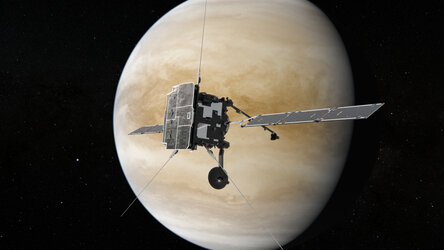Accept all cookies Accept only essential cookies See our Cookie Notice

About ESA
The European Space Agency (ESA) is Europe’s gateway to space. Its mission is to shape the development of Europe’s space capability and ensure that investment in space continues to deliver benefits to the citizens of Europe and the world.
Highlights
ESA - United space in Europe
This is ESA ESA facts Member States & Cooperating States Funding Director General Top management For Member State Delegations European vision European Space Policy ESA & EU Responsibility & Sustainability Annual Report Calendar of meetings Corporate newsEstablishments & sites
ESA Headquarters ESA ESTEC ESA ESOC ESA ESRIN ESA EAC ESA ESAC Europe's Spaceport ESA ESEC ESA ECSAT Brussels Office Washington OfficeWorking with ESA
Business with ESA ESA Commercialisation Gateway Law at ESA Careers Cyber resilience at ESA IT at ESA Newsroom Partnerships Merchandising Licence Education Open Space Innovation Platform Integrity and Reporting Administrative Tribunal Health and SafetyMore about ESA
History ESA Historical Archives Exhibitions Publications Art & Culture ESA Merchandise Kids Diversity ESA Brand Centre ESA ChampionsLatest
Space in Member States
Find out more about space activities in our 23 Member States, and understand how ESA works together with their national agencies, institutions and organisations.
Science & Exploration
Exploring our Solar System and unlocking the secrets of the Universe
Go to topicAstronauts
Missions
Juice Euclid Webb Solar Orbiter BepiColombo Gaia ExoMars Cheops Exoplanet missions More missionsActivities
International Space Station Orion service module Gateway Concordia Caves & Pangaea BenefitsLatest
Space Safety
Protecting life and infrastructure on Earth and in orbit
Go to topicAsteroids
Asteroids and Planetary Defence Asteroid danger explained Flyeye telescope: asteroid detection Hera mission: asteroid deflection Near-Earth Object Coordination CentreSpace junk
About space debris Space debris by the numbers Space Environment Report In space refuelling, refurbishing and removingSafety from space
Clean Space ecodesign Zero Debris Technologies Space for Earth Supporting Sustainable DevelopmentLatest
Applications
Using space to benefit citizens and meet future challenges on Earth
Go to topicObserving the Earth
Observing the Earth Future EO Copernicus Meteorology Space for our climate Satellite missionsCommercialisation
ESA Commercialisation Gateway Open Space Innovation Platform Business Incubation ESA Space SolutionsLatest
Enabling & Support
Making space accessible and developing the technologies for the future
Go to topicBuilding missions
Space Engineering and Technology Test centre Laboratories Concurrent Design Facility Preparing for the future Shaping the Future Discovery and Preparation Advanced Concepts TeamSpace transportation
Space Transportation Ariane Vega Space Rider Future space transportation Boost! Europe's Spaceport Launches from Europe's Spaceport from 2012Latest

Spider senses
Thank you for liking
You have already liked this page, you can only like it once!
Living in space requires more than just the astronauts’ bodies to adapt. The absence of a traditional up or down causes their brains to think in new ways and cope with the 3D world of weightlessness. Even trivial tasks on Earth like grasping an object can be difficult.
Understanding how astronaut brains cope is an important part of human spaceflight research. The sensations of floating for months on end is something our brains never had to deal with until last century and seeing how they adapt offers interesting clues to their workings.
Virtual reality headsets offer a way to present specific scenarios for testing to understand how an astronaut brain adapts to its new environment – so France’s CNES space agency has sent one to the International Space Station.
ESA astronaut Thomas Pesquet was the first to use the new-generation virtual reality gear, for the Grasp first experiment. Grasp saw Thomas reaching for virtual objects so researchers can understand how important gravity is compared to the other senses.
The focus is on how a brain combines the perception of its body with visual information to coordinate hand movement. Researchers suspect that, on Earth, the brain uses the sensations caused by gravity as a reference. When reaching for an object, for example, the brain will calculate how far your hand is by using visual clues as well as how much your shoulder muscles need to counteract the downward force of gravity and keep your arm straight.
Running tasks in space on a Perspectives headset allows researchers to fine-tune the parameters and eliminate other factors that would influence the results. Grasp saw astronauts repeat three tasks using a remote and their hands to compare results in a simplified world without distraction.
To stop the astronauts from floating away and bumping into things, they are strapped down. This picture shows the straps extending behind the operator while he holds the trackball in his right hand. Thomas set the equipment up on the International Space Station but he was not a test subject – up to 10 other astronauts are part of the study.
The research will help us understand the workings of the vestibular system that helps us keep our balance, and how it connects to the other sensory organs. In other words, Grasp is researching the physiology behind eye–hand coordination as well as shedding light on how to treat patients showing a loss of vestibular function on Earth.
For astronauts, the research will be useful during spacewalks where coordination in weightlessness with few visual clues is of utmost importance.
-
CREDIT
CNES-E. Grimault -
LICENCE
ESA Standard Licence

Grasping Gerst

A good GRASP on the New Year

Thomas grasping in VR space for science

Hanging for Grasp















 Germany
Germany
 Austria
Austria
 Belgium
Belgium
 Denmark
Denmark
 Spain
Spain
 Estonia
Estonia
 Finland
Finland
 France
France
 Greece
Greece
 Hungary
Hungary
 Ireland
Ireland
 Italy
Italy
 Luxembourg
Luxembourg
 Norway
Norway
 The Netherlands
The Netherlands
 Poland
Poland
 Portugal
Portugal
 Czechia
Czechia
 Romania
Romania
 United Kingdom
United Kingdom
 Slovenia
Slovenia
 Sweden
Sweden
 Switzerland
Switzerland
























